Robust Reinforcement Learning-Based Multiple Inputs and Multiple Outputs Controller for Wind Turbines
Abstract
:1. Introduction
- Using the reduced dynamic models of VSWT operation, which simplify the derivation of analytical expressions;
- Decomposing the control problem into subproblems, where each local control objective of the subsystem contributes to the achievement of the global goal of control.
1.1. Review of MIMO Controller Research for Wind Turbines
1.2. The Paper Contribution
- To overcome the above difficulties related to using MIMO control, the VSWT robust control problem in the presented paper was transformed into a class of optimal control problems by choosing the right cost functions for the nominal system. This means that such problems can be effectively solved with so-called model-free RL methods;
- The proposed model-free RL approach on the basis of the TRPO method allows examination of the parameters of decision-making policy with minimal designer input and without domain-specific knowledge in the form of marked-up samples, which makes RL a promising research tool for developing VSWT control systems. Traditional wind turbine control methods require domain knowledge and labeled samples for training. However, the proposed model-free RL approach enables learning without such prior knowledge or sample labeling. This means that the control system can autonomously learn and optimize its decision-making policy based on observed data, which is a novel and innovative approach. This makes it a promising tool for investigating and developing control systems for VSWT;
- The proposed approach is also not focused on or tailored to a specific wind turbine system. Due to the fact that an agent can learn from experience gained by interacting with the environment using a model-free method, the developed controller can be “tuned” to the required wind turbine system with minimal effort using recognized aerodynamic programs, such as FAST;
- The use of the TRPO method in the development of the controller is also a novel aspect. This method allows for the optimization of the control policy while considering constraints and safety, which is crucial in the operation of wind turbines. This is important for wind turbines, where it is necessary to comply with restrictions on rotor speed, blade loads, and other parameters to prevent damage and ensure safe operation.
2. Problem Statement
2.1. General Principles and Objectives of VSWT Control
- Controlling the blade pitch angle to follow the reference value of the generator speed , which depends on v, i.e., the blade pitch controller aims to minimize the absolute generator speed error ;
- Controlling the torque to reduce the absolute power error , where is the generated electric power and is the reference value of the electric power to be reached (which also depends on the wind speed, v).
2.2. General Applications of AI Methods to VSWT Control
3. Robust Model-Free RL-Based MIMO Controller
3.1. Reinforcement Learning
3.2. Trust Region Policy Optimization
- At each step, the agent chooses an action based on the current state using the control strategy ;
- The agent interacts with the environment and receives a reward for the action performed;
- The control strategy is updated based on the optimization of the value function and the control policy function using the TRPO method;
- The value function estimates the expected total reward from the current state to the end of episode T;
- The control policy function determines the probability of choosing each action based on the current state .
3.3. MIMO Controller Synthesis
- Action space: Since the control is responsible for the generator torque [kNm/s] and the total pitch [deg/s], the allowed actions are their speed changes;
- State space: The state of the wind turbine is selected as to characterize the operating parameters of the wind turbine, where is electric power produced [kW]; is trust [kN]; is the rotor speed [rpm]; is generator torque [kNm]; and is total pitch [deg];
- Observation space: Each observation of the environment consists of six dimensions of the state vector ;
- Transition probabilities: The transition probability is a characteristic of wind turbine dynamics. In this study, an OpenAI Gym environment was created using a model that realistically reproduced the behavior of a wind turbine by interacting with the open source CCBlade to calculate aerodynamic forces using Blade Element Momentum (BEM) theory. This theory is based on the assumption that a blade can be divided into small elements, called “blade elements”, each of which has its own aerodynamic characteristics. To calculate the aerodynamic characteristics of a blade using the BEM approach, the blade is broken down into small elements, each with its characteristics such as angle of attack, lift coefficient, and drag coefficient. Then, using the BEM equations, the thrust and moment generated by each element of the blade are calculated. The approach used reduces the BEM equations to a one-dimensional residual function—function :Reducing the BEM equations to a one-dimensional residual function means that the BEM equations can be represented as a single equation that depends on one variable only, i.e., the blade pitch. This allows for solving the BEM equations with optimization methods, in this case, those based on RL, to find the optimal blade pitch. The study presented in [33] demonstrated, through mathematical proof, that the methodology always finds a bracket to a zero of without any singularities in the interior. This proof, along with existing proofs for root-finding methods such as Brent’s method [34], implies that the solution is guaranteed. The CCBlade code model factors in both hub and tip losses using the Prandtl method and high induction factor correction [35]. The resistance is included in the calculation of the inductance factors.
- is the parameter vector of the linear-functional approximation of the blade pitch controller ;
- is the parameter vector of the linear-functional approximation of the generator torque controller .
4. Experiments
4.1. Dynamic Model
4.2. Case Study of the NREL 5 MW
4.3. Case Study of the Enercon E-126 EP3 4.0 MW
5. Conclusions
Funding
Data Availability Statement
Conflicts of Interest
Abbreviations
| MIMO | Multiple inputs and multiple outputs |
| VSWT | Variable-speed wind turbine |
| RL | Reinforcement learning |
| MPC | Model Predictive Control |
| AI | Artificial Intelligence |
| TRPO | Trust Region Policy Optimization |
| MPPT | Maximum power point tracking |
| MDP | Markov decision process |
| BEM | Blade Element Momentum |
| LQR | Linear quadratic regulator |
| DFIG | Doubly-Fed Induction Generator |
| FAST | Fatigue, Aerodynamics, Structures, and Turbulence |
| NREL | National Renewable Energy Laboratory |
| KL | Kullback–Leibler |
References
- Fernandez-Gauna, B.; Graña, M.; Osa-Amilibia, J.-L.; Larrucea, X. Actor-critic continuous state reinforcement learning for wind-turbine control robust optimization. Inf. Sci. 2022, 591, 365–380. [Google Scholar] [CrossRef]
- Khezami, N.; Benhadj Braiek, N.; Guillaud, X. Wind turbine power tracking using an improved multimodel quadratic approach. ISA Trans. 2010, 49, 326–334. [Google Scholar] [CrossRef]
- Boukhezzar, B.; Siguerdidjane, H. Nonlinear Control of a Variable-Speed Wind Turbine Using a Two-Mass Model. IEEE Trans. Energy Convers. 2011, 26, 149–162. [Google Scholar] [CrossRef]
- Rubio, J.O.M.; Aguilar, L.T. Maximizing the performance of variable speed wind turbine with nonlinear output feedback control. Procedia Eng. 2012, 35, 31–40. [Google Scholar] [CrossRef] [Green Version]
- Vali, M.; van Wingerden, J.-W.; Kühn, M. Optimal multivariable individual pitch control for load reduction of large wind turbines. In Proceedings of the 2016 American Control Conference (ACC), Boston, MA, USA, 6–8 July 2016; pp. 3163–3169. [Google Scholar] [CrossRef]
- Li, J.; Wang, S.; Hou, Z.; Zhao, J. Multivariable Model-Free Adaptive Controller Design with Differential Characteristic for Load Reduction of Wind Turbines. IEEE Trans. Energy Convers. 2022, 37, 1106–1114. [Google Scholar] [CrossRef]
- Evangelista, C.; Valenciaga, F.; Puleston, P. Active and Reactive Power Control for Wind Turbine Based on a MIMO 2-Sliding Mode Algorithm With Variable Gains. IEEE Trans. Energy Convers. 2013, 28, 682–689. [Google Scholar] [CrossRef]
- Yang, B.; Jiang, L.; Wang, L.; Yao, W.; Wu, Q.H. Nonlinear maximum power point tracking control and modal analysis of DFIG based wind turbine. Int. J. Electr. Power Energy Syst. 2016, 74, 429–436. [Google Scholar] [CrossRef] [Green Version]
- Muhando, E.B.; Senjyu, T.; Urasaki, N.; Yona, A.; Funabashi, T. Robust Predictive Control of Variable-Speed Wind Turbine Generator by Self-Tuning Regulator. In Proceedings of the 2007 IEEE Power Engineering Society General Meeting, Tampa, FL, USA, 24–28 June 2007; pp. 1–8. [Google Scholar] [CrossRef]
- Pintea, A.; Wang, H.; Christov, N.; Borne, P.; Popescu, D.; Badea, A. Optimal control of variable speed wind turbines. In Proceedings of the 2011 19th Mediterranean Conference on Control & Automation (MED), Corfu, Greece, 20–23 June 2011; pp. 838–843. [Google Scholar] [CrossRef] [Green Version]
- Lemmer, F.; Schlipf, D.; Cheng, P.W. Control design methods for floating wind turbines for optimal disturbance rejection. J. Phys. Conf. Ser. 2016, 753, 092006. [Google Scholar] [CrossRef]
- Wright, A.D.; Fingersh, L.J.; Stol, K.A. Design and Testing Controls to Mitigate Tower Dynamic Loads in the Controls Advanced Research Turbine. NREL/CP-500-40932, National Renewable Energy Laboratory. January 2007. Available online: http://www.nrel.gov/docs/fy07osti/40932.pdf (accessed on 13 July 2023).
- Soliman, M.; Malik, O.P.; Westwick, D.T. Multiple model MIMO predictive control for variable speed variable pitch wind turbines. In Proceedings of the 2010 American Control Conference, Baltimore, MD, USA, 30 June–2 July 2010; pp. 2778–2784. [Google Scholar] [CrossRef]
- Novak, J.; Chalupa, P. MIMO Predictive Control of a Wind Turbine. Int. J. Energy Environ. 2014, 8, 22–38. [Google Scholar]
- Sudarsana Reddy, K.; Mahalakshmi, R. A MIMO-Based Compatible Fuzzy Logic Controller for DFIG-Based Wind Turbine Generator. In Artificial Intelligence and Technologies; Raje, R.R., Hussain, F., Kannan, R.J., Eds.; Lecture Notes in Electrical Engineering; Springer: Singapore, 2022; Volome 806. [Google Scholar] [CrossRef]
- Meisam, M.; Francisco, J.; Verdú, R.R.A.; Augustine, A. Hybrid biomass, solar and wind electricity generation in rural areas of Fez-Meknes region in Morocco considering water consumption of animals and anaerobic digester. Appl. Energy 2023, 343, 121253. [Google Scholar] [CrossRef]
- Rezaei, M.M. A nonlinear maximum power point tracking technique for DFIG-based wind energy conversion systems. Eng. Sci. Technol. Int. J. 2018, 21, 901–908. [Google Scholar] [CrossRef]
- Njiri, J.G.; Söffker, D. State-of-the-art in wind turbine control: Trends and challenges. Renew. Sustain. Energy Rev. 2016, 60, 377–393. [Google Scholar] [CrossRef]
- Boukhezzar, B.; Lupu, L.; Siguerdidjane, H.; Hand, M. Multivariable control strategy for variable speed, variable pitch wind turbines. Renew. Energy 2007, 32, 1273–1287. [Google Scholar] [CrossRef]
- Vidal, Y.; Acho, L.; Luo, N.; Zapateiro, M.; Pozo, F. Power Control Design for Variable-Speed Wind Turbines. Energies 2012, 5, 3033–3050. [Google Scholar] [CrossRef]
- Chatterjee, J.; Dethlefs, N. Scientometric review of artificial intelligence for operations & maintenance of wind turbines: The past, present and future. Renew. Sustain. Energy Rev. 2021, 144, 111051. [Google Scholar] [CrossRef]
- Apata, O.; Oyedokun, D.T.O. An overview of control techniques for wind turbine systems. Sci. Afr. 2020, 10, e00566. [Google Scholar] [CrossRef]
- Kamel, R.M.; Chaouachi, A.; Nagasaka, K. Three Control Strategies to Improve the Microgrid Transient Dynamic Response During Isolated Mode: A Comparative Study. IEEE Trans. Ind. Electron. 2013, 60, 1314–1322. [Google Scholar] [CrossRef]
- Chowdhury, M.A.; Hosseinzadeh, N.; Shen, W.X. Smoothing wind power fluctuations by fuzzy logic pitch angle controller. Renew. Energy 2012, 38, 224–233. [Google Scholar] [CrossRef]
- Zeddini, M.A.; Pusca, R.; Sakly, A.; Mimouni, M.F. PSO-based MPPT control of wind-driven Self-Excited Induction Generator for pumping system. Renew. Energy 2016, 95, 162–177. [Google Scholar] [CrossRef]
- Iqbal, A.; Ying, D.; Saleem, A.; Hayat, M.A.; Mateen, M. Proposed particle swarm optimization technique for the wind turbine control system. Meas. Control. 2020, 53, 1022–1030. [Google Scholar] [CrossRef] [Green Version]
- Saenz-Aguirre, A.; Zulueta, E.; Fernandez-Gamiz, U.; Ulazia, A.; Teso-Fz-Betono, D. Performance enhancement of the artificial neural network-based reinforcement learning for wind turbine yaw control. Wind Energy 2020, 23, 687–701. [Google Scholar] [CrossRef]
- Sierra-Garcia, J.E.; Santos, M.; Pandit, R. Wind turbine pitch reinforcement learning control improved by PID regulator and learning observer. Eng. Appl. Artif. Intell. 2022, 111, 104769. [Google Scholar] [CrossRef]
- Li, H.; He, H. Learning to Operate Distribution Networks With Safe Deep Reinforcement Learning. IEEE Trans. Smart Grid 2022, 13, 1860–1872. [Google Scholar] [CrossRef]
- Wang, Z.; Yu, Y.; Gao, W.; Davari, M.; Deng, C. Adaptive, Optimal, Virtual Synchronous Generator Control of Three-Phase Grid-Connected Inverters Under Different Grid Conditions—An Adaptive Dynamic Programming Approach. IEEE Trans. Ind. Inform. 2022, 18, 7388–7399. [Google Scholar] [CrossRef]
- Vu, N.T.T.; Nguyen, H.D.; Nguyen, A.T. Reinforcement Learning-Based Adaptive Optimal Fuzzy MPPT Control for Variable Speed Wind Turbine. IEEE Access 2022, 10, 95771–95780. [Google Scholar] [CrossRef]
- Schulman, J.; Levine, S.; Abbeel, P.; Jordan, M.; Moritz, P. Trust Region Policy Optimization. In Proceedings of the 32nd International Conference on Machine Learning, Lille, France, 7–9 July 2015; Bach, F., Blei, D., Eds.; Proceedings of Machine Learning Research. Volume 37, pp. 1889–1897. Available online: http://proceedings.mlr.press/v37/schulman15.pdf (accessed on 8 June 2023).
- Ning, S.A. A simple solution method for the blade element momentum equations with guaranteed convergence. Wind Energy 2013, 17, 1327–1345. [Google Scholar] [CrossRef]
- Brent, R.P. An algorithm with guaranteed convergence for finding a zero of a function. Comput. J. 1971, 14, 422–425. [Google Scholar] [CrossRef]
- Buh, M.L. A New Empirical Relationship between Thrust Coefficient and Induction Factor for the Turbulent Windmill State; NREL/TP-500-36834; National Renewable Energy Laboratory: Golden, CO, USA, 2005; pp. 32–58. [Google Scholar]
- Jonkman, J.; Butterfield, S.; Musial, W.; Scott, G. Definition of a 5-MW Reference Wind Turbine for Offshore System Development; Technical Report; National Renewable Energy Laboratory: Golden, CO, USA, 2009. [Google Scholar]
- Enercon E-126 EP3 4.0MW. Retrieved from wind-turbine-models.com. 2018. Available online: https://www.enercon.de/fileadmin/Redakteur/Medien-Portal/windblatt/pdf/Windblatt_03_18_GB_Web.pdf (accessed on 8 June 2023).
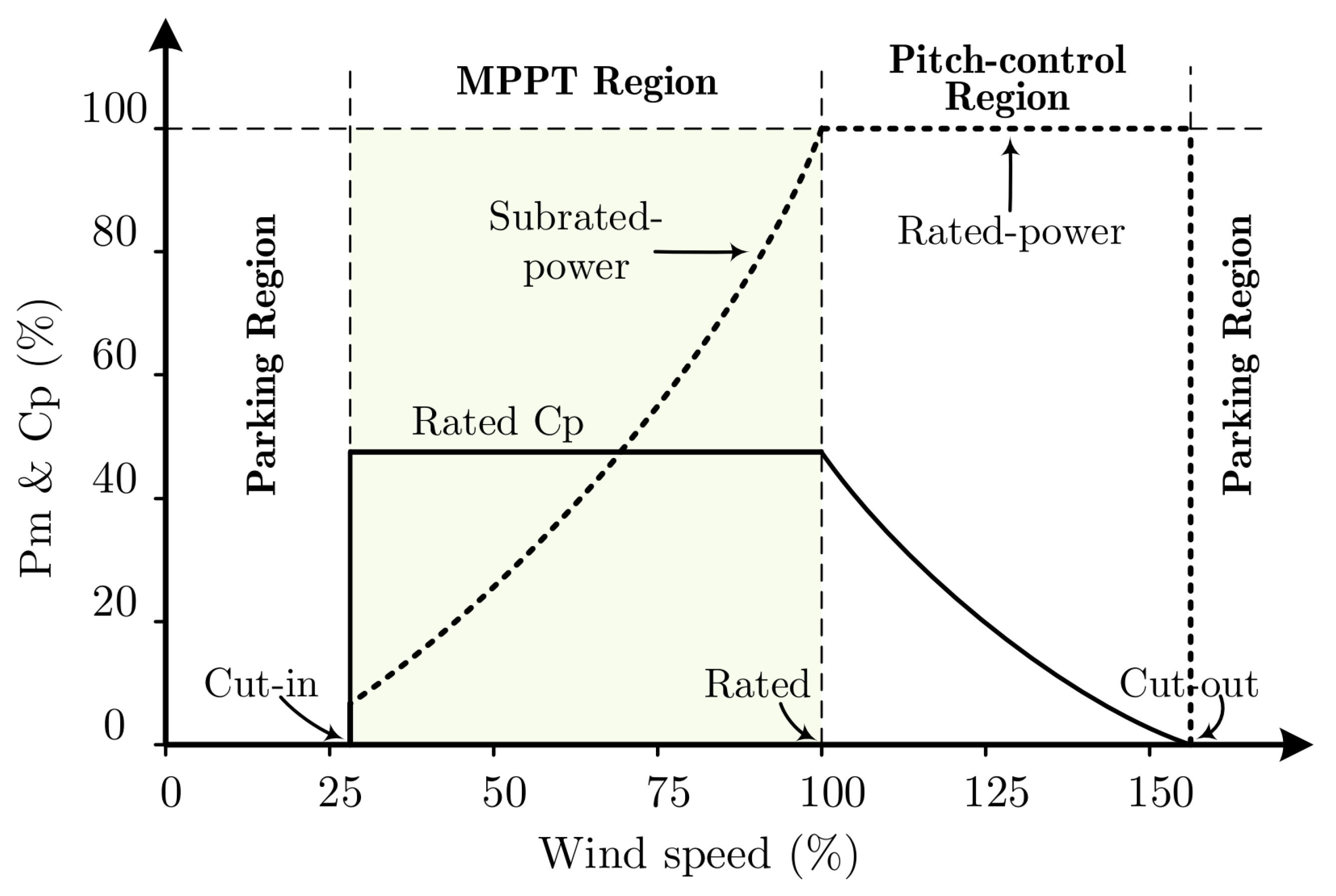
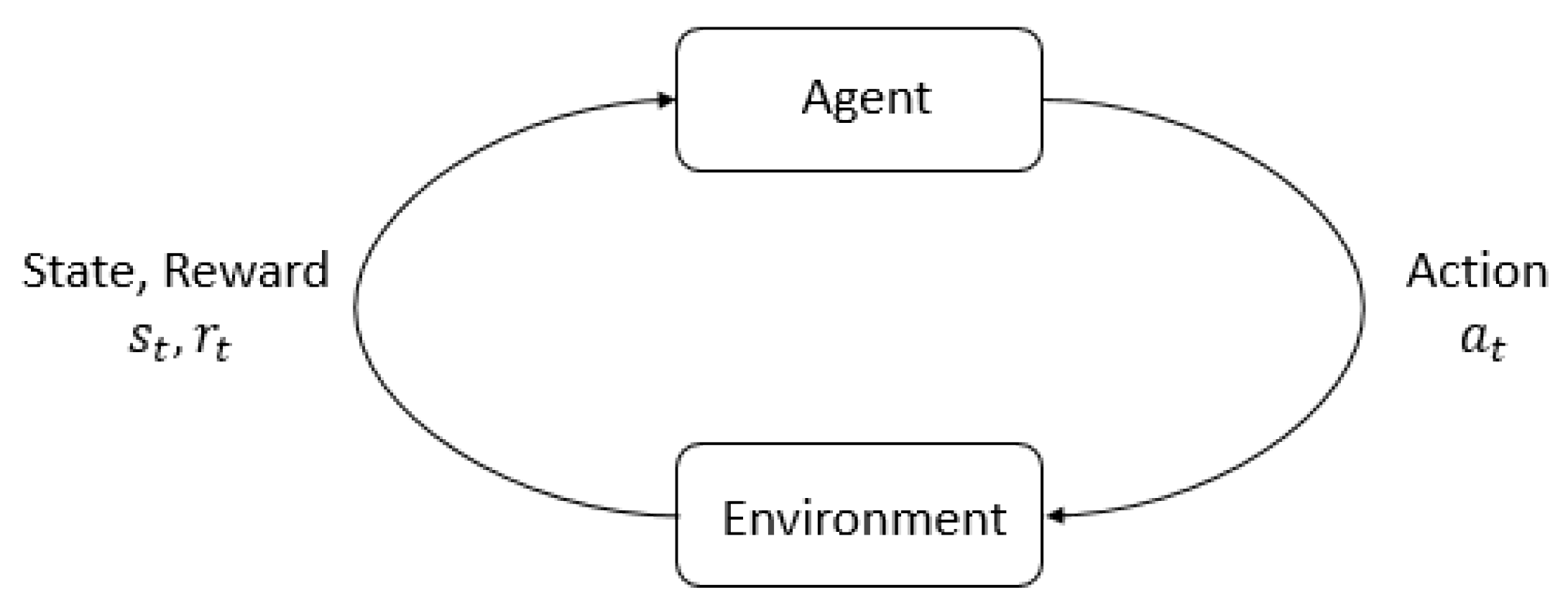
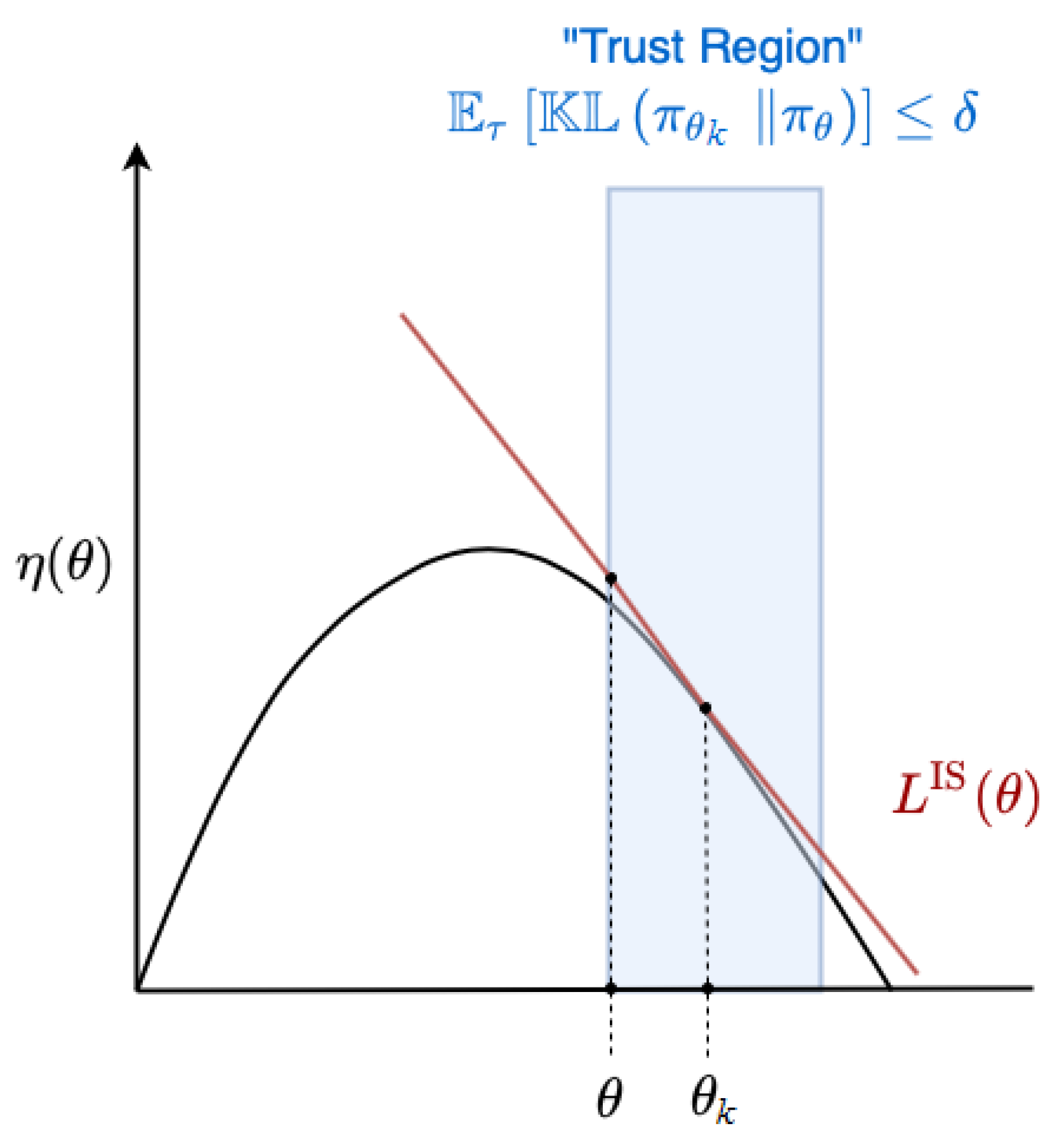
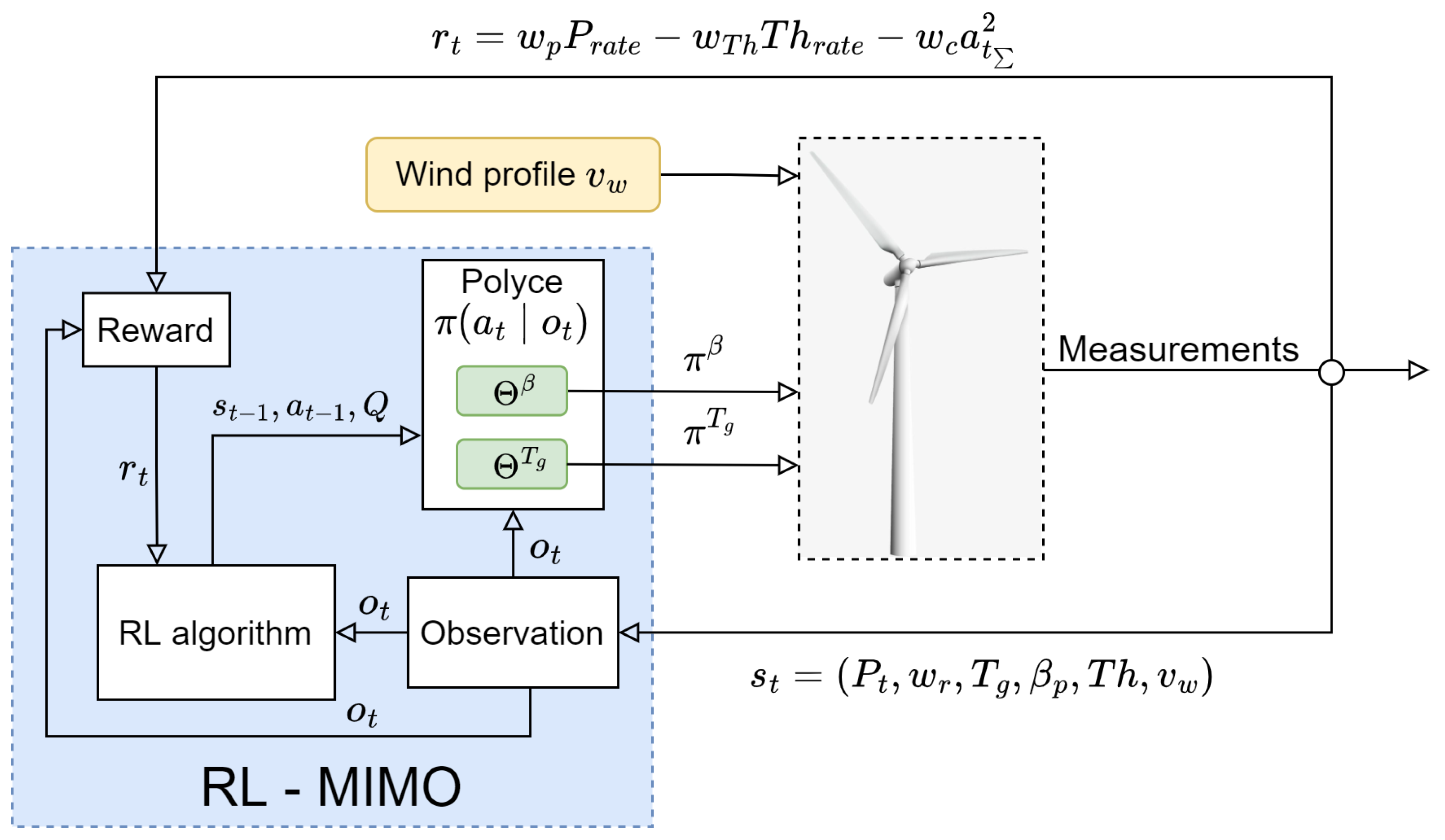

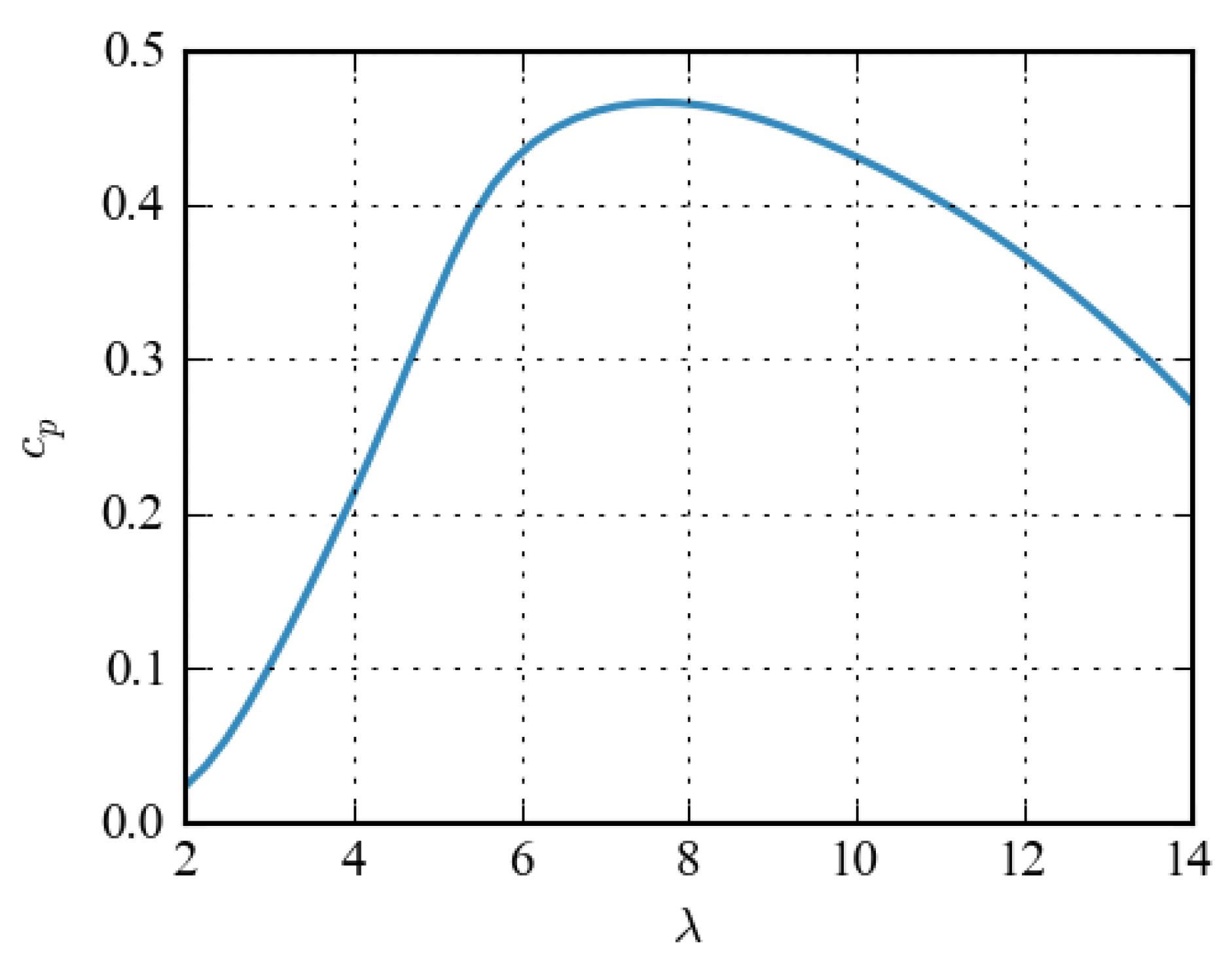

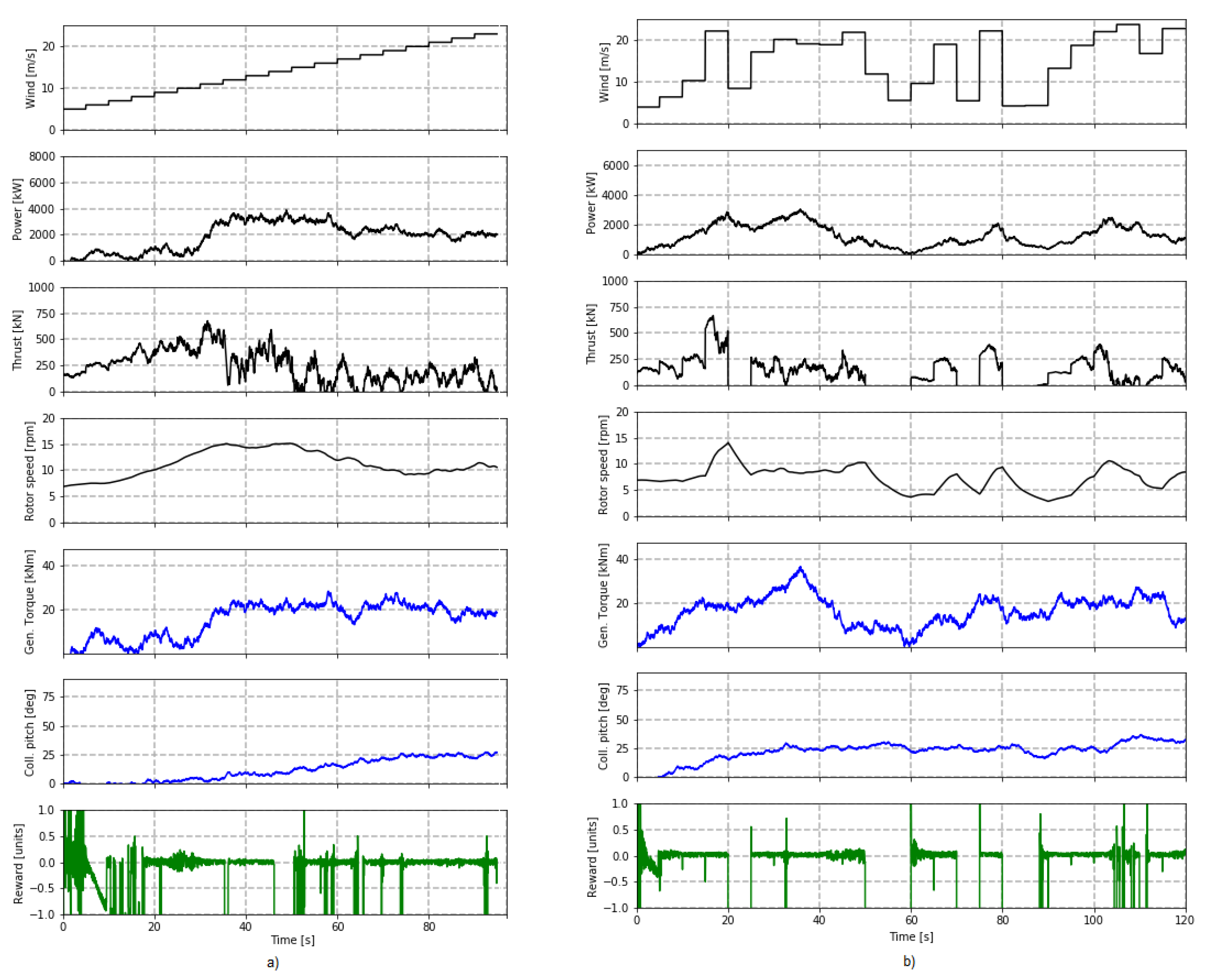

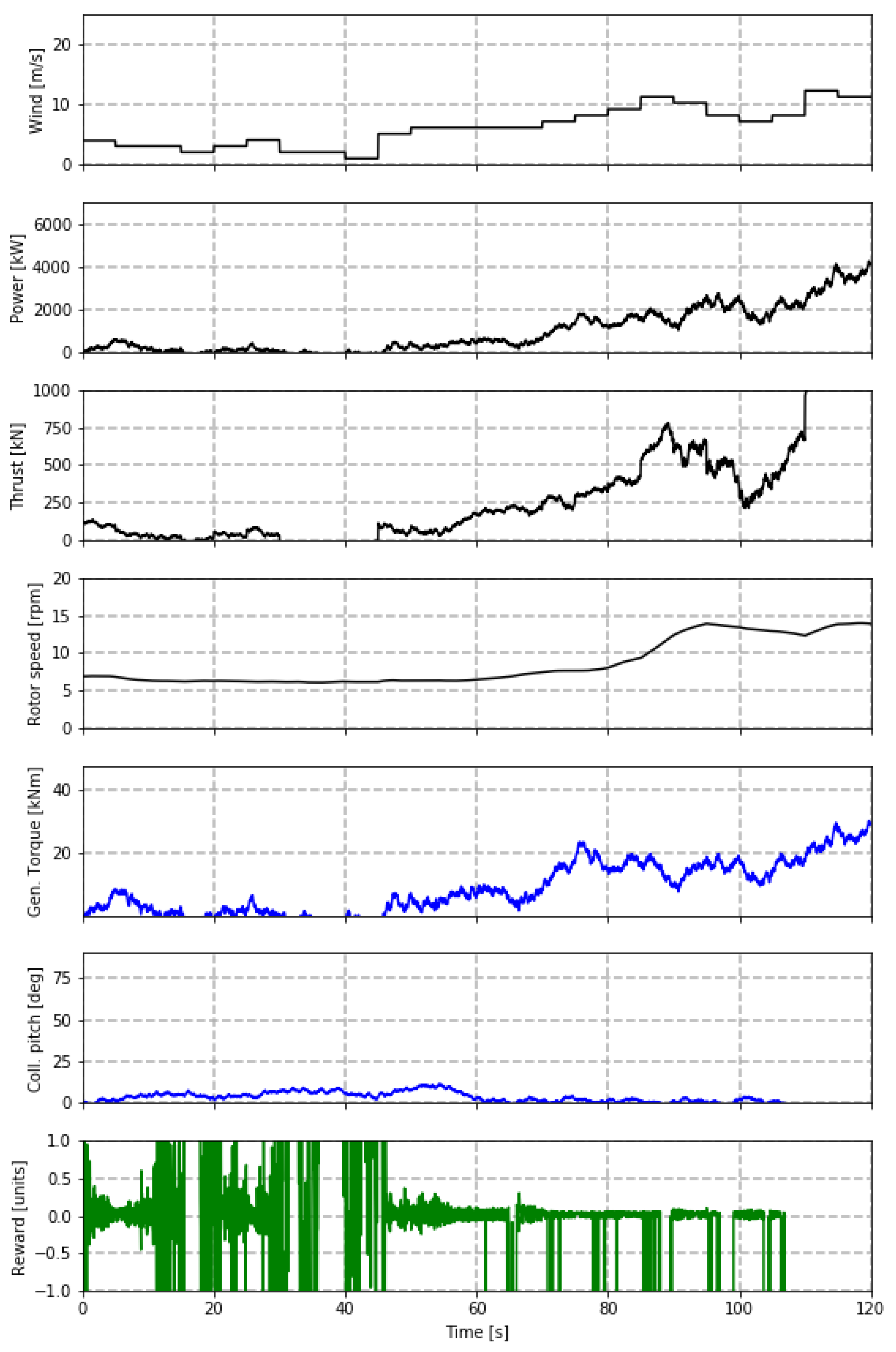
| Reference | Method | MIMO Controller Operation Principle | Controlled Parameters |
|---|---|---|---|
| [5] | Mixed sensitivity optimization | MIMO individual pitch controller | Blade root flap-wise bending moments |
| [6] | Dual multivariable model-free adaptive control strategy | Passive MIMO fault-tolerant individual pitch controller | The components of each blade |
| [7] | Second-order sliding modes and Lyapunov methods | MIMO second-order sliding controller | Reactive power and generator torque |
| [8] | Partial linearization and Lyapunov stability method | MIMO controller that achieves fully decoupled control of the external dynamics of a DFIG-based wind turbine | Multiple variables |
| [9] | Self-tuning regulator | MIMO pitch + generator speed | Blade pitch angle and generator torque |
| [10,11,12] | Linear quadratic regulator | MIMO pitch + generator speed controller | Blade pitch angle and generator torque |
| [13,14] | Model predictive control and fuzzy logic | MIMO pitch + generator speed controller | Blade pitch angle and generator torque |
| [1] | Reinforcement learning | MIMO pitch + generator speed controller | Blade pitch angle and generator torque |
| [15] | Fuzzy logic | MIMO-Based MSC+GSC controller | Modulation indexes for the GSC and MSC controllers. |
| Index | Name and Units | Min | Max |
|---|---|---|---|
| 1 | Wind speed [m/s] | 3 | 25 |
| 2 | Power generated [kW] | 0 | 7000 |
| 3 | Thrust [kN] | 0 | 1000 |
| 4 | Rotor speed [rpm] | 0 | 15 |
| 5 | Generator torque [kNm] | 0.606 | 47.403 |
| 6 | Collective pitch [deg] | 0 | 90 |
| Index of Actions | Name and Units | Min | Max |
|---|---|---|---|
| 0 | Generator torque rate [kN·m/s] | ||
| 1 | Collective pitch rate [deg/s] |
Disclaimer/Publisher’s Note: The statements, opinions and data contained in all publications are solely those of the individual author(s) and contributor(s) and not of MDPI and/or the editor(s). MDPI and/or the editor(s) disclaim responsibility for any injury to people or property resulting from any ideas, methods, instructions or products referred to in the content. |
© 2023 by the author. Licensee MDPI, Basel, Switzerland. This article is an open access article distributed under the terms and conditions of the Creative Commons Attribution (CC BY) license (https://creativecommons.org/licenses/by/4.0/).
Share and Cite
Tomin, N. Robust Reinforcement Learning-Based Multiple Inputs and Multiple Outputs Controller for Wind Turbines. Mathematics 2023, 11, 3242. https://doi.org/10.3390/math11143242
Tomin N. Robust Reinforcement Learning-Based Multiple Inputs and Multiple Outputs Controller for Wind Turbines. Mathematics. 2023; 11(14):3242. https://doi.org/10.3390/math11143242
Chicago/Turabian StyleTomin, Nikita. 2023. "Robust Reinforcement Learning-Based Multiple Inputs and Multiple Outputs Controller for Wind Turbines" Mathematics 11, no. 14: 3242. https://doi.org/10.3390/math11143242
APA StyleTomin, N. (2023). Robust Reinforcement Learning-Based Multiple Inputs and Multiple Outputs Controller for Wind Turbines. Mathematics, 11(14), 3242. https://doi.org/10.3390/math11143242





